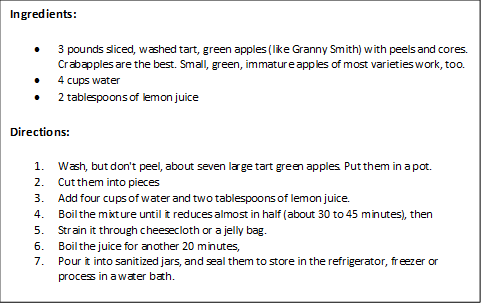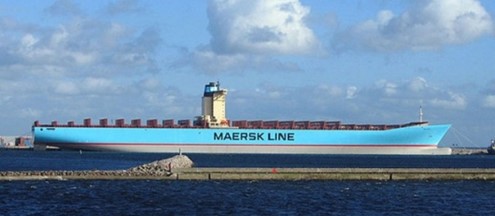This is a continuation of a previous blog on Solar Jam. Because I used a commercial form of pectin that was imported from Denmark, I decided to think about this some more and re-examine everyday life in search of a better path to sustainable living.

Imported and Domestic Pectin Options
I chose to use “commercial” pectin purchased at a local Whole Foods grocery store. It would have been possible to make my own pectin as described in http://www.pickyourown.org/makeyourownpectin.htm just as my grandparents did using natural local ingredients. Here’s a recipe for Tart / Green Apple Pectin:

The pectin I used for the 2014 batch of Chokecherry jam was actually made in Denmark. ‘Pomona Universal Pectin’ is an amazing human invention, in that it does not require copious amounts of sugar to create the chemical reaction that results in the “jelling” effect. Instead, the jellying effect is produced by the addition of calcium supplied in a separate package from the pectin. As a result the advertised shelf life of ‘Pomona Universal Pectin’ is “Keeps Indefinitely.” In past years I used a pectin product made in the U.S. that does require sugar to form a jell.
When thinking about how the little 1.1 oz (31 grams) packet of pectin left Denmark and arrived at the local Whole Foods store near us, we of course have to envision a “container ship” sailing from Denmark to the U.S. – possibly one owned by the Danish shipping line Mærsk. Five years ago, they owned eight of world’s largest container ship ships. Each are 1300 ft (397.7m) long and can carry 15,200 shipping containers around the globe at a steady 25.5 knots (47.2 km/h, 29.3 mph). The mammoth engines that propel these container ships consume approximately 16 tons of low grade “bunker fuel” per hour or 380 tons per day while at sea.
Container Ships such as this are over four football fields long.
This form of fossil fuel is literally the sludge from the bottom of the barrel – so thick it must be heated to flow. Basically it is asphalt, but it is inexpensive. Bunker fuel contains up to 2,000 times the amount of sulfur in the diesel fuel we use in cars and trucks.
Why haven’t I heard about this source of air / water pollution? The exhaust products from the ships are generated out in the ocean. Out of sight out of mind allows us to ignore it as an environmental or climate change problem. Granted there is no immediate effect to a local population of humans. Nevertheless all the contaminants including sulfur, mercury, lead, and other heavy metals are present and dispersed in the air and ocean over the entire voyage of the container ship. This obviously has a detrimental effect on those living systems in its path.
Collectively, the world has over 90,000 ships that in turn burn over 7 million barrels of bunker fuel each day. For perspective, 300 million Americans burn 18 million barrels of petroleum every day. As someone who tries not to but often does buy imported goods, rather than limit my options to products made locally, I contribute to this insanity without even thinking about the ramifications on climate change /global warming / air & water pollution.
For more details, see: “Big polluters: one massive container ship equals 50 million cars” by Paul Evans, April 23, 2009
http://www.gizmag.com/shipping-pollution/11526/
Of course once the pectin arrived at a port on the east coast, its container was unloaded and its contents transported on land to warehouses and distribution centers. The boxes of pectin eventually ended up in Denver – with the expenditure of additional fossil fuel.
The direct costs of transportation (e.g.the cost of the bunker fuel for the container ship and diesel fuel for the 18 wheeler) are embedded in the cost of the product as it sits on the shelf at Whole Foods. However the social costs of getting the Denmark pectin to a local retailer in Denver are “externalized” (ignored) and paid by the public (most of whom have no clue I was the one who supported the long distance import of this item by buying it and thereby contributing to further pollution of everyone’s air and water.)
The Pectin Story is a simple illustration of a broken social system. Everyone followed the prevailing rules. No one was convicted of a crime. If any law was circumvented, it occurred without detection. People profited. I probably saved a few minutes by buying what I could have made. Everyone involved behaved within the rules/guidelines of our current economic / political / legal social system. So what’s the problem? The system is influencing us to make choices that are unsustainable – thats a broken system.
Young people can quickly see that this adult behavior is causing harm to fish in the sea. They know us adults are dumping harmful things into the air they breathe and the water they drink and the food they eat. Then why can’t we?
We adults created this current (broken) social system that is influencing us to make choices that are clearly unsustainable. It is our responsibility to change it / fix it before we do more harm. More and more people are suggesting that our current application of capitalism is at the root of this cidal (suicidal, homicidal, genocidal, ecocidal) behavior – including Naomi Klein in her latest book, “This changes Everything.” Profit has become more important than People. Yet there are many ethical economists urging us to fix the economic system by eliminating externalities (ignored costs). For example in the energy sector, if we made a Pigovian correction that puts a price on carbon pollution, the cost of dirty fuels (such as “bunker fuel”) would include a carbon burning/pollution fee. As a result, the market would see the true cost of the “dirtier” fuels and automatically choose the cleaner (cheaper) sources of energy to power ships, planes, trains, cars and trucks.
We will explore other approaches to changing our behavior in future blogs.

[…] discussed in more detail in Solar Jam (II) – Appendix A: The Pectin Story, importing commercial pectin from Denmark via a current day container ship was a small mistake from […]